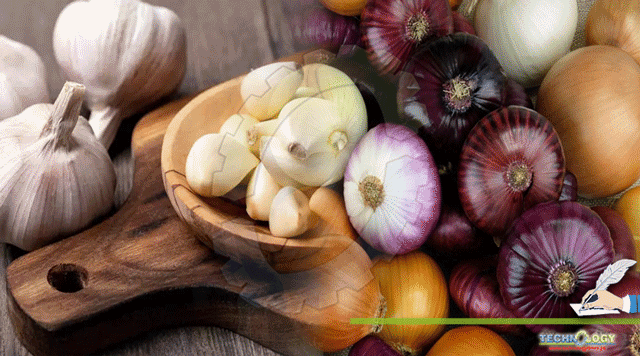Garlic and onion have been of medicinal value in the treatment of hypertension and they are also used by people who wanted to lose weight.

By Uzma Nasrullah
Introduction
These common food plants are a rich source of several phytonutrients recognized as important elements of the Mediterranean diet, but are also used in the treatment and prevention of a number of diseases, including cancer, coronary heart disease, obesity, hyperchol esterolemia, diabetes type 2, hypertension, cataract and disturbances of the gastrointestinal tract (e.g. colic pain, flatulent colic and dyspepsia). These activities are related to the thiosulfinates, volatile sulfur compounds, which are also responsible for the pungent of these vegetables. Besides these low-molecular weight compounds, onion and garlic are characterized by more polar compounds of phenolic and steroidal origin, often glycosilated, showing interesting pharmacological properties.
Clinical Importance
The organosulphur compounds (allicin and isoallicin) of these bulbs will be of great therapeutic importance in the treatment of some diseases of the eye (e.g glaucoma), cardiovascular system (e.g hypertension, tachycardia), neuromuscular junction (e.g myastheniagravis), and nervous system (e.g Alzheimer’s disease) and also in the treatment of atropine toxicity.
Effect on the Eye
Glaucoma is a disease characterized by increased intraocular pressure in which cholinesterase inhibitor like allicin for these bulbs reduces the intraocular pressure by causing cilliary muscles contraction thereby facilitating outflow of aqueous humour.
Effect on the Gastrointestinal and Urinary Tract
They can be helpful in the treatment of constipation due to their effect of increasing gastrointestinal tract mobility. They can also be indicated in the treatment of reflux oesophagitis because they cause increase in tone of contraction of the lower oesophageal sphincter.They can also be indicated in patients with urinary retention as they cause contraction of the smooth detrusor muscles of the urinary bladder.
Effect on the Neuromuscular Junction
Disease of neuromuscular junction such mysathenia gravis which is a condition of the body producing autoimmunity against acetylcholine can be treated by the administration of the organosulphur compounds of garlic and onion which prevent breaking down of available acetylcholine that will bind to the available receptors at the neuromuscular junction.
Effect on the Cardiovascular System
They can be used in the management of hypertension due to their effect of vasodilating the blood vessels thereby causing decrease in the total peripheral resistance ultimately leading to decrease in blood pressure and they can be used in the treatment of supraventricular tachycardia due to its negative chronotropic and negative ionotropic effect on the heart.
Effect on the Central Nervous System
Allicin has been reported to have therapeutic value in the treatment of Alzheimer’s disease just as tacrine which is also an anticholinesterase.
Toxicity and Side Effects
The toxic effect of garlic and onion like other cholinesterase inhibitor is seen over usage.Signs of acute intoxication are muscarinic excess such as miosis,salivation, sweating, bronchial constriction, vomiting, diarrhea,hypotension, acute bradycardia, conlvusion, syncope, coma, and polyuria.The treatment is the use of atropine parenterally so as to neutralize the toxicity.
Health Benefits of Onion Flavonoids
Besides as a vegetable and in condiments, onions are popularly consumed due to their medicinal properties. Onion flavonoids have several health enhancing effects. Anti-oxidative activity is one of the major medicinal properties of onion flavonoids. Onion sulphur compounds and flavonoids such as quercetin derivatives are known to have a hypoglycemic effect and thus can act as antidiabetic food. Flavonoids also play an important role in protection from neurodegeneration and neuro-inflammation. Onion flavonoids are considered as an aphrodisiac in Indian folk medicine. Sperm quality and testosterone content were significantly increased in diabetic rats upon administration of quercetin (Khaki et al., 2010).
Benefits & Uses of Garlic
Garlic is one of the important bulb crops grown and used as a spice or a condiment throughout India. Allicin present in aquous extract of garlic reduces cholesterol concentration in human blood. Garlic extract has antimicrobial activity against many genera of bacteria, fungi and viruses. Garlic contains a higher concentration of sulfur compounds which are responsible for its medicinal effects. The inhalation of garlic oil or garlic juice has generally been recommended by doctors in case of pulmonary tuberculosis, rheumatism, sterility, impotency, cough and red eyes. Garlic possesses insecticidal action. About 1% garlic extract gives protection against mosquitoes for 8 hours. Extract of garlic along with chilli and ginger has beneficial action against soil nematodes. Beneficial use of garlic extract has been found against many fungi. Garlic is probably one of the earliest known medicinal plants, which used from ancient time to cure different disease conditions in human.
Garlics principal medicinal uses are to lower blood pressure and cholesterol, fight infections, and prevent cancer. The main interest of researchers in the medicinal values of garlic is its broad-spectrum therapeutic effect with minimal toxicity. Garlic extract has antimicrobial activity against many genera of bacteria, fungi and viruses. Literature survey support garlics effectiveness as a mild antihypertensive, lowering blood pressure by 5-7%. Garlic inhibits platelet aggregation and enhances fibrinolytic activity, reducing clots on damaged endothelium. Another important use of garlic is as antidiabetic. Garlic controls the blood sugar level by different types of mechanisms. In vitro studies and animal data suggest that garlic may help to prevent some solid tumors. Therefore, garlic is also effective in the cancer prevention. There are no studies evaluating its effectiveness in treating children or pregnant or nursing women.
Authors : Uzma Nasrullah Univeristy of Agriculture Faisalabad